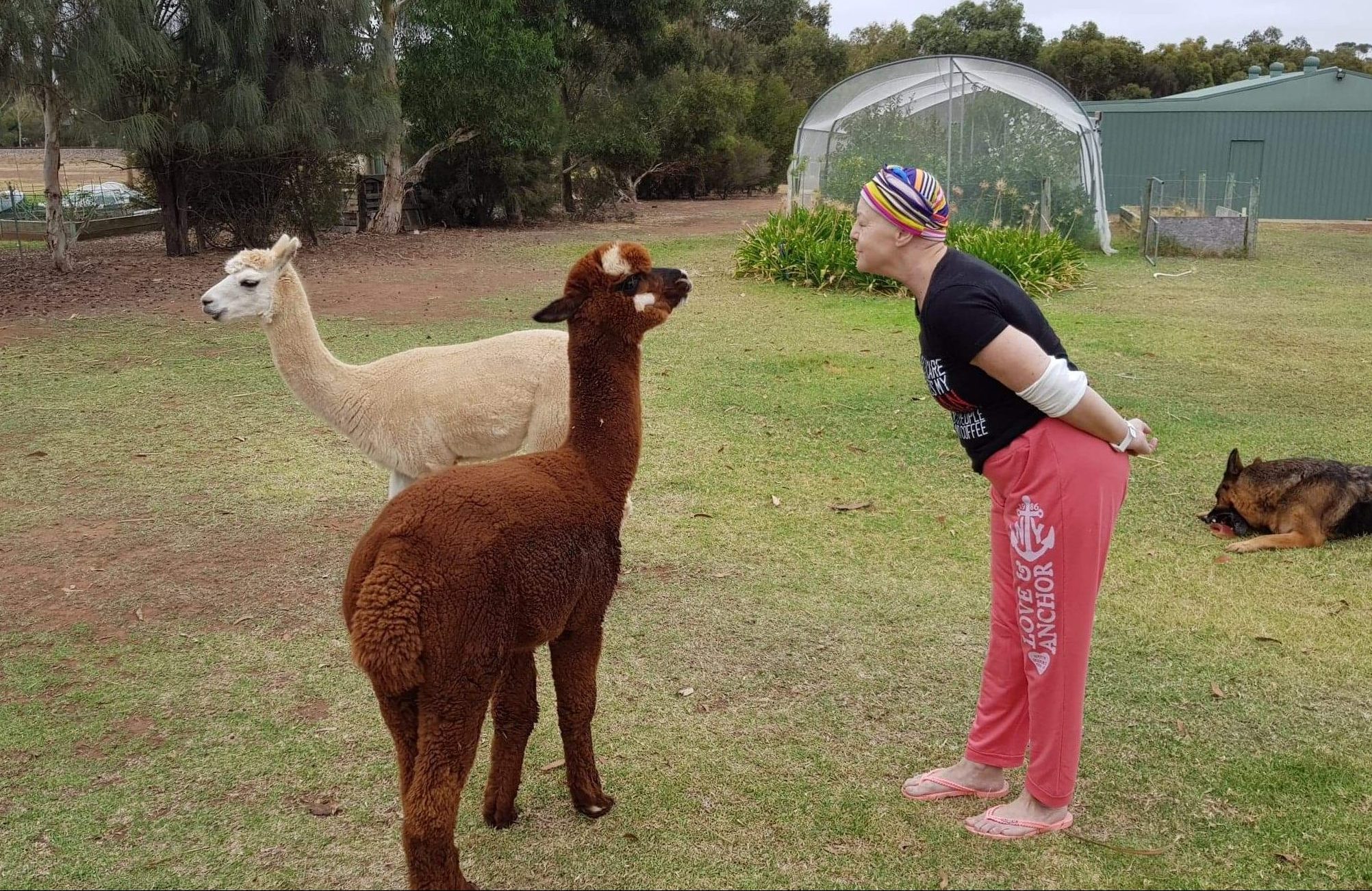Tereena goes to her “happy place” when she’s in pain or discomfort

Tereena Cocks, 52, has practised meditation and visualisation almost as long as she’s been living with blood cancer, and that’s more than half her life.
She was 24 when she was diagnosed with essential thrombocythaemia (an MPN) and has had many different therapies over the years on watch and wait.
“My disease was ‘recalcitrant’,” said Tereena, “I’d constantly swing between really high counts and really low counts, with episodes of extremely painful clots or nasty bleeds.
“My maintenance therapy was a knife’s edge; it was very difficult for my haematology team to manage,” said Tereena, who lives with husband, Craig, on acreage, an hour south of Adelaide, with their two German shepherds and two alpacas.
Learning to manage pain
“When I was first diagnosed, I had a lot of bone pain. At a pain unit, I learnt self-hypnosis and autogenic relaxation*.
“Back in those days, I was an ambulance paramedic and didn’t want to have anything that would interfere with my cognition.
“So, I learnt other ways to cope with the discomfort, by natural means, rather than by taking opiate-type drugs,” she said.
“I’m an hour away from the nearest major hospital which means I’d have at least an hour of severe pain, and meditation helps a lot with that.
“And during admission, when I’d have tests like having a needle stuck into a joint, I’d just go off to my happy place.”
Benefits of relaxing deeply
“When you’ve got a bad illness and the doctors are all fluffing over you, your life is in a bit of a spin and you tend to lose control,” said Tereena.
“This whole relaxation thing helps when you’re out of your comfort zone and there’s nothing you can do about it. You just calm your whole body down. I find that to be absolutely wonderful.”
Relaxation technique
“I mainly do visualisation and autogenic relaxation,” she said.
“It involves finding a comfortable, relaxed position, and having a mantra that you go through in your mind.
“You think about your toes first, give your toes a bit of a wriggle, and internally say, ‘my toes are warm and relaxed’, and you wriggle them and let them relax.
“Then you give your calves a bit of a flex and say to yourself, ‘my calves are warm and relaxed’.
“You work your way up and through lots of different areas of your body and it’s amazing where you’ll find you’re holding on to tension.
“There’s a breathing part and when you get to your lungs, you take nice deep breaths in and out. It’s a really relaxing thing to do.”
Tereena said the amount of time she devotes to this practice depends on how much time she’s got and what she’s using it for.
“You can do it very quickly when you need to, but you can also take as much time as you like when you’ve got no other things to do. It’s just a matter of training.”
Myelofibrosis and leukaemia
In October last year, Tereena found out her disease had transformed to an aggressive form of myelofibrosis. Then two weeks later, she was diagnosed with acute myeloid leukaemia.
When Tereena spoke to our Living Well e-News, she was Day 60 after having an allogeneic bone marrow transplant in April.
She used visualisation a lot while she was away from home for her transplant. And she had “a bit of assistance”.
“I’ve got external security cameras at my house and I can use my telephone to access my cameras when I’m away, in hospital.
“I have that in the background, and when I’m lying in the hospital room, I can picture myself at home and being well – it’s such a comfort.
“I can hear all the familiar noises of home and the sounds of the animals outside and the birds flying over.”
For people without home security cameras, Tereena suggests they record the sounds of home to listen to during lengthy periods of time in hospital.
“I was in a really bad state when I was in hospital. I had Grade 4 mucositis – the worst it can possibly get.
‘I couldn’t eat or drink a single thing and had TPN nutrition. It was really painful, and that’s when I’d go into my happy place, to get me through all of that.”
Coping with cancer
Having worked in the health industry all her life, Tereena knows the benefits of a good mental state.
During challenging times in hospital, she thinks to herself… “each minute is a minute I don’t have to have again”, “I don’t have to do the last five minutes again”, and “today’s a different day and one day closer [to recovering]”.
“I just plod on, one foot in front of the other, always steps forward,” said Tereena.
“And I live each day to the best of my capabilities, enjoying the little things and not worrying about what I can’t change.”
Soon after her diagnosis, Tereena read a book about living in the moment, written by Vietnamese Buddhist monk, Thich Nhat Hanh. She’s still got The Miracle of Mindfulness on her bedside table.
“You can learn some amazing things from it,” said Tereena, who practises mindfulness daily, usually in the morning.
“It puts you in a really good mental attitude. You feel good about the day, before it starts.
“I honestly think that if you put all this positive stuff in and around you then that’s what happens in your day… it comes back to you.
“It’s not just for when you’re in pain or unwell, it’s something good to use in life every single day.”
September is Blood Cancer Awareness Month, helping to raise awareness of every blood cancer. Learn more.
* A technique that involves progressive relaxation of the body’s extremities, heartbeat stabilisation, and maintenance of slow, deep breaths.